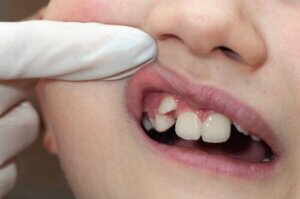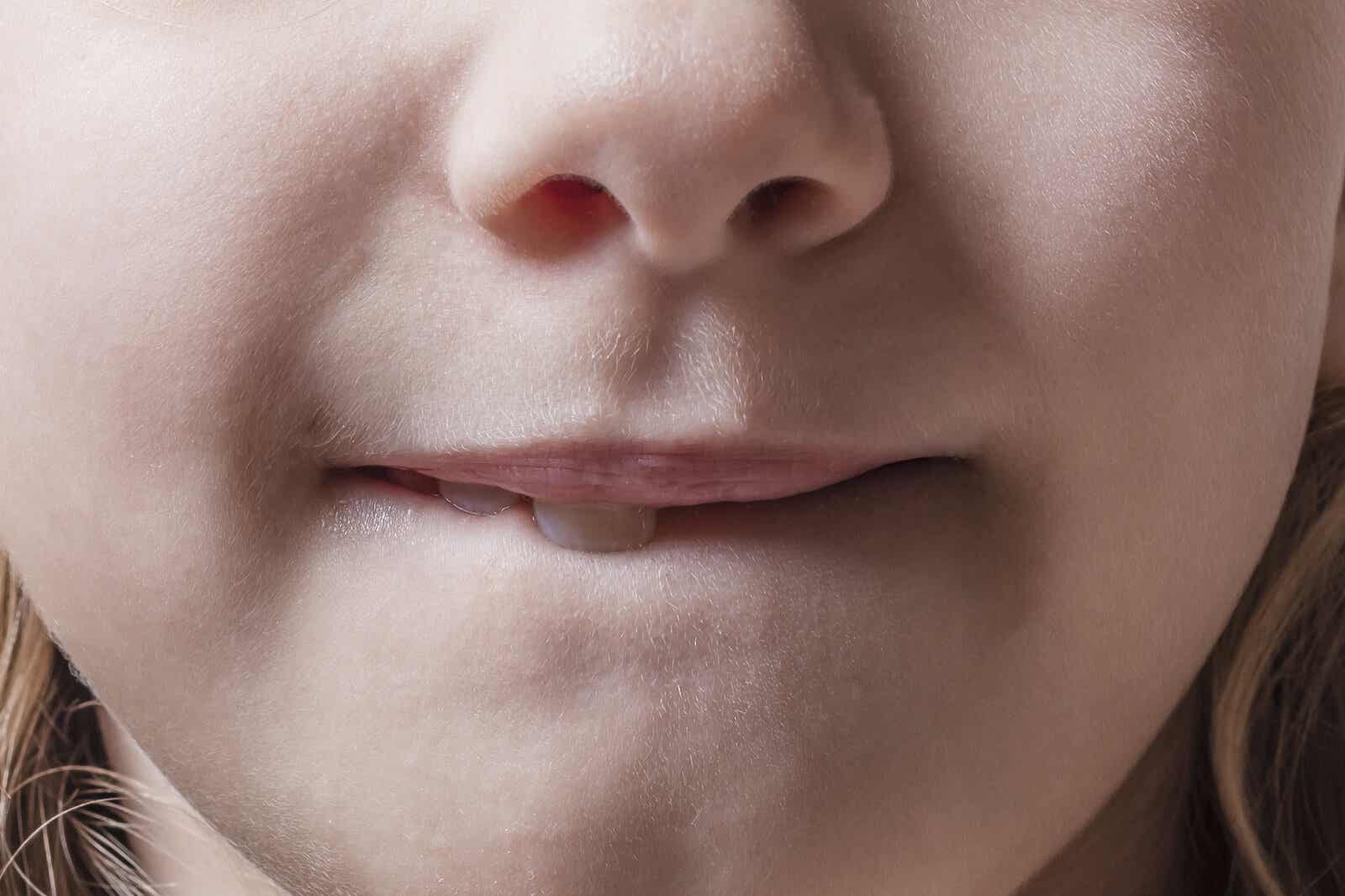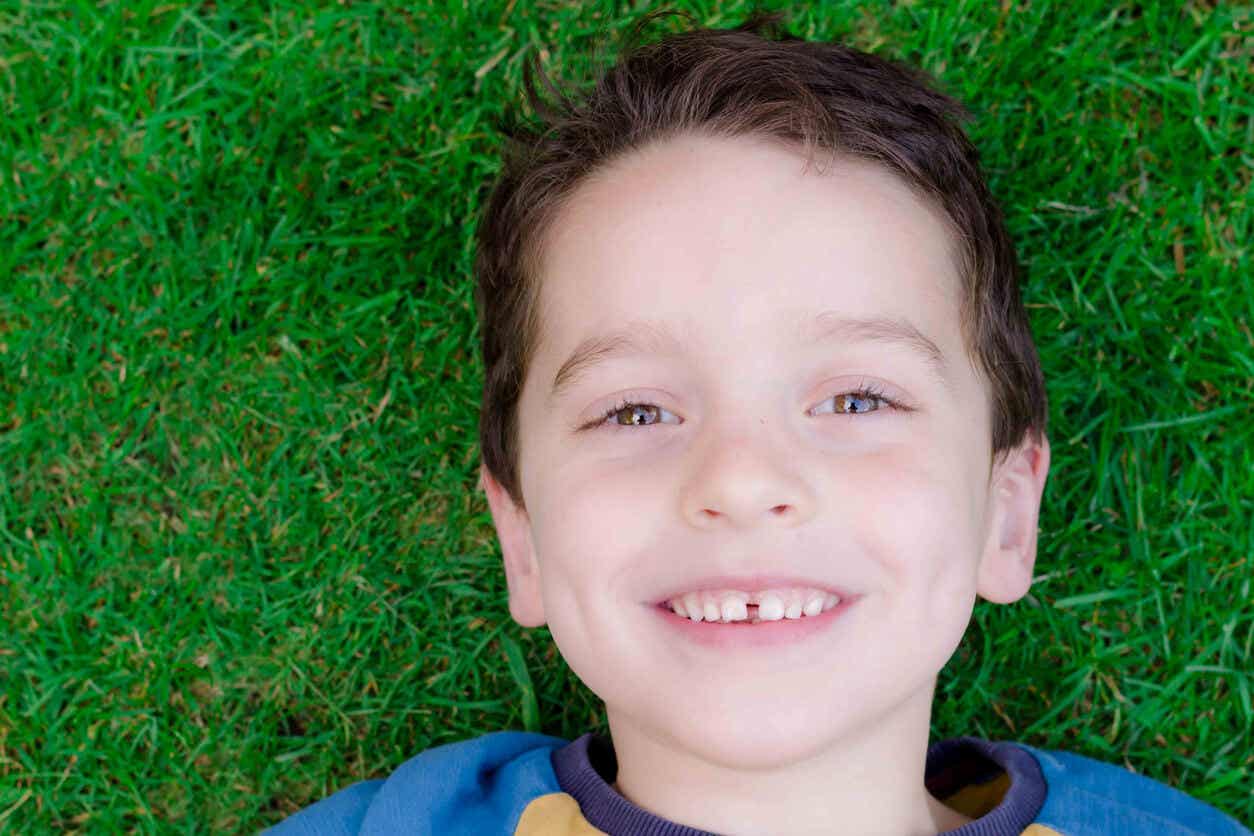Bite Problems in Children: What You Should Know

During childhood, it’s very common to have bite problems. These problems are mainly an alteration in how the jawbone or teeth should line up. When this happens, the position of the upper teeth doesn’t coincide with the position of the lower teeth.
It’s true that when people have these problems, they mostly care about aesthetic issues and the appearance of the face. However, bite problems in children affect their everyday lives. This is because they can interfere with the way they eat as well as the way they speak. In addition, bite problems can cause headaches and pain in the jaw.
Therefore, identifying and treating these problems during childhood is essential to having a better and more essential treatment. It’s important to know that there are many different types of bite problems, as well as their causes.
Causes of bite problems in children
As we’ve mentioned before, there are many causes of bite problems in children. The combination of maxillary bones formation, teeth eruption, and the action of certain habits can give rise to these problems in childhood.

The following are the most common causes:
- Heredity: There are certain conditions that involve the shape and size of the bones. In fact, these are transmitted from generation to generation, repeating the same pattern of the mouth in various members of the family.
- Dysfunctional habits: Persistent sucking habits, such as breastfeeding, using pacifier a or a bottle, and finger sucking after the age of 2 can lead to bite problems in children. Repetitive habits, such as the interposition of the tongue or the lips when biting or swallowing, biting their nails, or breathing through the mouth may also lead to the appearance of these alterations.
- The premature loss of baby teeth: If baby teeth are lost prematurely, either due to dental cavities, infections, or trauma, it can lead to the eruption and occlusion of the permanent teeth.
- Other causes: The presence of other conditions of the mouth can also give rise to bite problems in children. Suffering from cysts, tumors in the mouth, having too many teeth or teeth with abnormal locations, jaw trauma, and fissures of the lips or palate are some examples of these other possible causes.
The most common bite problems in children
Bite problems in children affect the way teeth from the mouth relate to each other. This not only affects the appearance of the smile, but also the way the children speak and chew.
The diagnosis of these alterations is carried out by the dentist in their office, through dental examination and complementary methods, such as X-rays, photographs, and the study of plaster models of the patient’s mouth. It’s important to visit the dentist frequently in order to detect and treat any possible abnormality immediately.
During childhood, the bones of the jaw are growing and dentists use this situation to treat bite problems in children. That’s why treatments are easier, faster, and more effective.
Next, we’ll give you more details about bite problems in children:
- Class 1: In this case, the upper and lower jaws relate to one another properly, but the dental elements have some incorrect positions. For example, there may be crowding, diastemas, or overbites.
- Class 2: When this happens, the upper jaw is in front of the lower jaw. Besides, the upper teeth appear when closing the mouth. This is associated with finger sucking habits, prolonged use of pacifiers or bottles, and breathing through the mouth.
- Class 3: In this case, the lower jaw is in front of the upper jaw. Prognathism may be observed, which is when the jaw protrudes forward.
Other possible problems
Besides the reasons we’ve just mentioned, there are other possible causes that may lead to bite problems in children:
- Dental crowding: This refers to the superposition of the teeth with one another. It happens due to lack of space, which doesn’t allow teeth to grow in properly. Crowded dental elements not only affect aesthetics but also interfere with dental hygiene, favoring the installation of other illnesses, such as cavities, gingivitis, and periodontitis.
- Diastemas: It’s an exaggerated space between the teeth. It can happen because teeth are too small or the bone is too big. It may have to do with the premature loss of teeth and the habit of pushing the teeth with the tongue.

- Crossbite: There’s an alteration in the transverse relationship of the jaws. When closing the mouth, one or more upper teeth land inside the lower teeth.
- Open bite: In this case, when closing the mouth, the upper teeth can’t make contact with the lower teeth. What’s more, there’s a space between the two jaws, which affects children’s chewing, swallowing, and speech production.
- Overbite: In this case, when closing the mouth, the upper teeth cover the lower teeth too much.
What can you do to avoid bite problems in children?
Many times, it’s not possible to avoid bite problems in children. However, putting these tips into practice is convenient in order to take care of their mouth.
It’s important to treat and solve certain habits that can favor the appearance of these disorders. Therefore, you should try to avoid finger sucking, the use of pacifiers and bottles after children are 2 years of age, and treat mouth breathing.
It’s also quite convenient for children to eat different foods with different textures and hardnesses to stimulate facial muscles. Moreover, maintaining proper oral hygiene is vital to avoiding common illnesses that can lead to premature tooth loss.
In addition, as we’ve already mentioned, visiting a pediatric dentist regularly from an early age is essential. The dentist will be able to notice any possible problem in children’s bites and start proper treatment as soon as possible. Finally, treatments will depend on the different needs of each child’s clinical case and age. For example, dentists may recommend the use of interceptive orthodontics, removable appliances, or braces.
The best thing to do is to make good use of children’s bone and teeth growth and development. Therefore, try to pay attention frequently to the way your child bites and, if you notice something strange in the bite, don’t hesitate to ask a dentist for advice.
During childhood, it’s very common to have bite problems. These problems are mainly an alteration in how the jawbone or teeth should line up. When this happens, the position of the upper teeth doesn’t coincide with the position of the lower teeth.
It’s true that when people have these problems, they mostly care about aesthetic issues and the appearance of the face. However, bite problems in children affect their everyday lives. This is because they can interfere with the way they eat as well as the way they speak. In addition, bite problems can cause headaches and pain in the jaw.
Therefore, identifying and treating these problems during childhood is essential to having a better and more essential treatment. It’s important to know that there are many different types of bite problems, as well as their causes.
Causes of bite problems in children
As we’ve mentioned before, there are many causes of bite problems in children. The combination of maxillary bones formation, teeth eruption, and the action of certain habits can give rise to these problems in childhood.

The following are the most common causes:
- Heredity: There are certain conditions that involve the shape and size of the bones. In fact, these are transmitted from generation to generation, repeating the same pattern of the mouth in various members of the family.
- Dysfunctional habits: Persistent sucking habits, such as breastfeeding, using pacifier a or a bottle, and finger sucking after the age of 2 can lead to bite problems in children. Repetitive habits, such as the interposition of the tongue or the lips when biting or swallowing, biting their nails, or breathing through the mouth may also lead to the appearance of these alterations.
- The premature loss of baby teeth: If baby teeth are lost prematurely, either due to dental cavities, infections, or trauma, it can lead to the eruption and occlusion of the permanent teeth.
- Other causes: The presence of other conditions of the mouth can also give rise to bite problems in children. Suffering from cysts, tumors in the mouth, having too many teeth or teeth with abnormal locations, jaw trauma, and fissures of the lips or palate are some examples of these other possible causes.
The most common bite problems in children
Bite problems in children affect the way teeth from the mouth relate to each other. This not only affects the appearance of the smile, but also the way the children speak and chew.
The diagnosis of these alterations is carried out by the dentist in their office, through dental examination and complementary methods, such as X-rays, photographs, and the study of plaster models of the patient’s mouth. It’s important to visit the dentist frequently in order to detect and treat any possible abnormality immediately.
During childhood, the bones of the jaw are growing and dentists use this situation to treat bite problems in children. That’s why treatments are easier, faster, and more effective.
Next, we’ll give you more details about bite problems in children:
- Class 1: In this case, the upper and lower jaws relate to one another properly, but the dental elements have some incorrect positions. For example, there may be crowding, diastemas, or overbites.
- Class 2: When this happens, the upper jaw is in front of the lower jaw. Besides, the upper teeth appear when closing the mouth. This is associated with finger sucking habits, prolonged use of pacifiers or bottles, and breathing through the mouth.
- Class 3: In this case, the lower jaw is in front of the upper jaw. Prognathism may be observed, which is when the jaw protrudes forward.
Other possible problems
Besides the reasons we’ve just mentioned, there are other possible causes that may lead to bite problems in children:
- Dental crowding: This refers to the superposition of the teeth with one another. It happens due to lack of space, which doesn’t allow teeth to grow in properly. Crowded dental elements not only affect aesthetics but also interfere with dental hygiene, favoring the installation of other illnesses, such as cavities, gingivitis, and periodontitis.
- Diastemas: It’s an exaggerated space between the teeth. It can happen because teeth are too small or the bone is too big. It may have to do with the premature loss of teeth and the habit of pushing the teeth with the tongue.

- Crossbite: There’s an alteration in the transverse relationship of the jaws. When closing the mouth, one or more upper teeth land inside the lower teeth.
- Open bite: In this case, when closing the mouth, the upper teeth can’t make contact with the lower teeth. What’s more, there’s a space between the two jaws, which affects children’s chewing, swallowing, and speech production.
- Overbite: In this case, when closing the mouth, the upper teeth cover the lower teeth too much.
What can you do to avoid bite problems in children?
Many times, it’s not possible to avoid bite problems in children. However, putting these tips into practice is convenient in order to take care of their mouth.
It’s important to treat and solve certain habits that can favor the appearance of these disorders. Therefore, you should try to avoid finger sucking, the use of pacifiers and bottles after children are 2 years of age, and treat mouth breathing.
It’s also quite convenient for children to eat different foods with different textures and hardnesses to stimulate facial muscles. Moreover, maintaining proper oral hygiene is vital to avoiding common illnesses that can lead to premature tooth loss.
In addition, as we’ve already mentioned, visiting a pediatric dentist regularly from an early age is essential. The dentist will be able to notice any possible problem in children’s bites and start proper treatment as soon as possible. Finally, treatments will depend on the different needs of each child’s clinical case and age. For example, dentists may recommend the use of interceptive orthodontics, removable appliances, or braces.
The best thing to do is to make good use of children’s bone and teeth growth and development. Therefore, try to pay attention frequently to the way your child bites and, if you notice something strange in the bite, don’t hesitate to ask a dentist for advice.
All cited sources were thoroughly reviewed by our team to ensure their quality, reliability, currency, and validity. The bibliography of this article was considered reliable and of academic or scientific accuracy.
- Méndez, Julieta, Rosario Rotela, and Ana Gonzalez. “Prevalencia de Maloclusión en niños de 6 A 12 años de la ciudad de Coronel Oviedo, Paraguay, Año 2016.” Memorias del Instituto de Investigaciones en Ciencias de la Salud 18.2 (2020): 86-92. https://revistascientificas.una.py/ojs/index.php/iics/article/view/539
- España Angulo, Pedro Daniel. Respiración bucal y maloclusión dentaria en niños de 6 a 10 años. BS thesis. Universidad de Guayaquil. Facultad Piloto de Odontología, 2019. http://repositorio.ug.edu.ec/handle/redug/44166
- Monzon Mendoza, Gerson Joao. “Prevalencia de Maloclusión dental en niños de 8 a 12 años de edad, atendidos en el centro de salud Coishco, provincia del Santa, departamento de Áncash, año 2019.” http://repositorio.uladech.edu.pe/handle/123456789/20367
- Tume, Paiva, and Betsy Santitos. “Relación entre los hábitos orales perniciosos y las maloclusiones dentarias según la clasificación molar de Angle, en niños con dentición mixta entre 7 y 12 años de edad, en el área de odontopediatría, de la clínica odontológica Uladech Católica-provincia de Trujillo, región La Libertad, año 2016.” (2018). https://alicia.concytec.gob.pe/vufind/Record/ULAD_ea9e3caf2e931fed289ce38457822a54
- López Gallegos, E., et al. “Prevalencia de habitos deletereos y maloclusiones en dentición mixta en niños de la ciudad de Quito, Ecuador.” (2018). http://www.dspace.uce.edu.ec/handle/25000/16693
- Martínez Ramos, Maira Raquel, et al. “Características de la oclusión dentaria en niños de 4 y 5 años.” Medisan 21.11 (2017): 3221-3226. http://scielo.sld.cu/scielo.php?pid=S1029-30192017001100011&script=sci_arttext&tlng=pt
- Albarracín-Pintado, Marcia P., and Liliana Encalada-Verdugo. “Relación entre apiñamiento dentario y el índice de higiene oral en escolares de 12 años.” Revista Peruana de Investigación en Salud 5.1 (2021): 7-10. http://revistas.unheval.edu.pe/index.php/repis/article/view/756
- SÁNCHEZ, BRENDA IVONNE AQUINO, et al. “Diastemas interincisales en dentición permanente.” Llamkasun 2.1 (2021): 73-85. http://llamkasun.unat.edu.pe/index.php/revista/article/view/32
- Astegiano, Carolina, et al. “Ortopedia funcional: Alternativa de tratamiento para la mordida abierta anterior.” IV Jornadas de Actualización en Prácticas Odontológicas Integradas PPS-SEPOI (La Plata, 7 de julio de 2020). 2020. http://sedici.unlp.edu.ar/handle/10915/100677
This text is provided for informational purposes only and does not replace consultation with a professional. If in doubt, consult your specialist.








